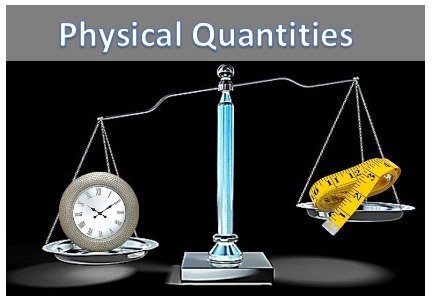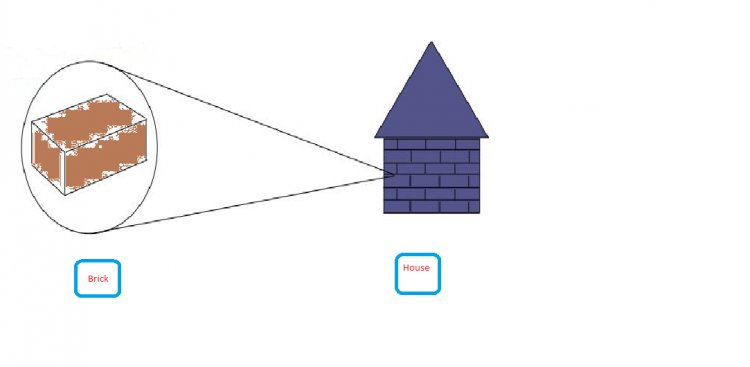Physical quantities and its types
Physical quantities and its types

Physical quantities
Physical quantities defination:
A physical quantity is a particular thing that has a value and a unit of measurement.
For example the height of a student is 5cm. Here "5" is numerical magnitude and "cm" is the unit of measurement.
Physical quantities in physics:
Physical quantities are measurable properties or characteristics of objects, substances or phenomena in the physical world. These are specific aspects that can be quantified using numerical values and appropriate units of measurement.
Types of physical quantities:
They are classified into two types:
• Base quantity
• Derived quantities
|
Base quantities are the quantities used as the foundation for expressing other quantities. For example: it is like |
Derived quantity The quantities that are expressed in terms of base quantities are referred to as derived quantities.
|

History of physical quantities:
The concept of physical quantities and their measurement has a long and evolving history going back thousands of years. Here is a brief overview of the history of physical quantities:
Ancient times:
Ancient civilizations such as the Egyptians, Babylonians and Greeks were among the first to develop practical systems of measurement. They used body parts such as the arm or leg as a unit of length and established basic units for weight and volume.
Classical antiquity:
The Greeks made important contributions to the understanding of physical quantities. The mathematician and philosopher Pythagoras introduced the concept of numerical relations to music and mathematics.
The philosopher Plato emphasized the importance of mathematics as a fundamental aspect of reality.
Aristotle classified physical quantities into categories such as time, space, motion, and substance. His work laid the foundation for later scientific research.
Middle Ages and Renaissance:
In the Middle Ages, scientific progress slowed in Europe, but Islamic scholars preserved and expanded the knowledge of ancient Greece. Scholars such as Al-Kindi, Al-Farabi and Avicenna made great strides in physics, mathematics and astronomy.
The Renaissance period saw a resurgence of interest in the natural world and the scientific method. Illustrious personalities such as Galileo Galilei and Johannes Kepler have made important contributions to the understanding of motion and the laws governing it.
Scientific Revolution:
The scientific revolution of the 16th and 17th centuries brought about a paradigm shift in the understanding of physical quantities. Scientists such as Sir Isaac Newton have developed mathematical models to describe the behavior of physical phenomena such as the laws of motion and gravity.
Newton's work laid the foundation for the development of classical mechanics and the concept of fundamental physical quantities such as mass, length and time.
18th and 19th century:
During this time, progress has been made in several areas of physics. French mathematician Joseph-Louis Lagrange developed analytical mechanics, which expanded Newtonian mechanics and introduced the concept of energy.
Electromagnetism emerged in the 19th century, to which scientists such as Michael Faraday and James Clerk Maxwell made important contributions. Maxwell's equations combined the theories of electricity and magnetism and introduced the concept of electromagnetic waves.
Modern time:
The 20th century brought about revolutionary changes in our understanding of physical quantities. Albert Einstein's theory of relativity, formulated in 1905 and 1915, expanded our understanding of space, time and mass by introducing the famous equation E=mc².
Quantum mechanics, developed by physicists such as Max Planck, Werner Heisenberg and Erwin Schrödinger, introduced a probabilistic approach to the behavior of subatomic particles and challenged the classical concepts of determinism.
The development of particle physics and the discovery of fundamental particles such as protons, neutrons and electrons have further expanded our understanding of the fundamental building blocks of matter.
Modern time:
Recently, the study of physical quantities has expanded beyond traditional physics into interdisciplinary fields such as biophysics, geophysics and astrophysics. Technological progress has led to increasingly accurate measurement methods and the discovery of new physical phenomena.
In addition, the emergence of theories such as string theory and attempts to unify the fundamental forces of nature continue to push the boundaries of our understanding of physical quantities.
The history of physical quantities is an ongoing journey of discovery and refinement, and new ideas and discoveries continue to shape our understanding of the universe.
A physical quantity is a measurable quantity used to describe the physical world.
Here are some examples of physical quantities:
There are a number of physical properties that we can measure. All these properties are related to the size of the object or its structure. Seven elementary physical quantities:
Mass:
This is a property that tells us how much matter an object contains. An object with a large amount of matter has a large mass. Force acting on the mass of an object is weight. Mass and weight are often confused. Weight Comparison:
.
Length:
This is a property that tells us the length of an object. This property is related to the surface and volume properties.
Time:
This property is related to the event flow and is always incremented. Like mass, time cannot be negative. Time tells us about the movement of things in the universe.
Electric charge:
This is a physical quantity that can be positive or negative and affects only polarity. This causes a force to act on matter when it is placed in an electric field.
Temperature:
This is a property that measures the amount of heat in a substance or object. Heat is related to the movement of particles in an object.
Mole:
Mole is a fixed physical quantity that measures the number of molecules in a substance. A property is an exact number of particles or molecules equal to substance molecules.
Brightness:
This is a measure of energy, just like temperature. Luminosity measures the amount of electromagnetic energy emitted by an object in the form of light per unit time.
Derived physical quantity:
The quantities volume, density, and the area can be determined from more than one measurement.The volume of a rectangular body is calculated by multiplying the length, width and height. Derived quantities are always expressed in some unit.
Examples of derived physical quantities are surface area and volume.
Area: This is a two-dimensional quantity that represents the amount of area. The standard area unit can be expressed in SI units using square meters. It is usually defined on a flat surface or a spherical surface. In length, width and height area is measured. The sum of a rectangle's base and height gives the area of the shape.
Volume: This is the amount of 3D space enclosed in a closed surface. Volume often uses the SI-derived unit, the cubic meter, numerically. It also measures horsepower. Volume is the volume of space occupied by an object such as a solid, liquid or gas. Measured in cubic units. The volume of a substance is the distribution of a substance's mass by its density. There are other units of volume: liter, fluid ounce, gallon, quart, pint, and so on.
Remark. The physical quantity is used to calculate the occupied substances. Some physical quantities are more fundamental than others. Give numerical values for physical quantities and also give equations for physical principles.
What's Your Reaction?





















